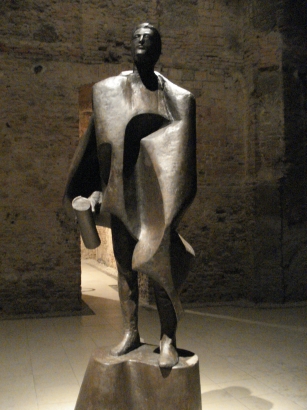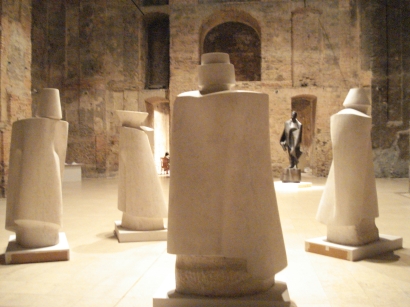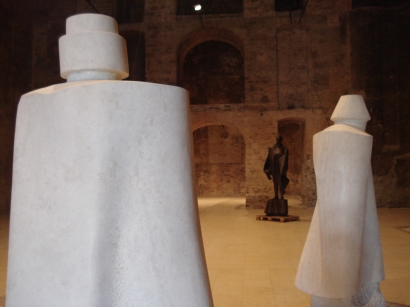VÍGH TAMÁS
Going Forward, After Forty Years
It is not unprecedented in the history of art, but neither is it common, for a monument to be erected several decades after it was designed. It is just such a rarity that we are witnessing now.
It was in the first days of 1967 that the National Water Authority commissioned Tamás Vígh to design a monument to Pál Vásárhelyi and the regulation of the River Tisza. It was to be erected in the village of Tiszadob. After nearly a year of officious quibbling under the name of “contemplation by the jury,” the client gave up on the work by Tamás Vígh and architect Jenő Bálint and set up another monument in Tiszadob.
The five figures of the design have been alive and well for forty years in the form of small sculptures: all five have been displayed in the National Gallery and several copies of the single bronze figure of Vásárhelyi (Hungarian engineer from the 19th century) have been seen in exhibitions and collections, giving some idea of what the official view of the time just could not accept. But the whole large-scale could only be imagined, because it remained just a large-scale design.
The composition, a diagonally-cut hill with four large stone-carved wheelbarrow-plying kubikos (“navvy”) figures at the top and the bronze figure of the engineer in the centre, was not approved for completion. A monument truly worthy of Vásárhelyi’s struggle and achievement was denied to the public for several decades.
Pál Vásárhelyi was addressing one of the great economic challenges of his time. He belonged to a school of Hungarian engineers who distinguished themselves during the reform era and have done so ever since. Vásárhely was an outstanding figure and technical pioneer, but he was drawing on well-established precedents when he set out in his work to regulate the River Tisza. That his works were only partly successful was not his failing, but was due to the familiar landowning despots protecting their own interests at all costs. His efforts were enough to turn the Tisza into a navigable waterway and to greatly mitigate flood damage. It is both his achievement and his tragedy which make him one of the great figures of water conservancy, river regulation and engineering.
Tamás Vígh’s plan embraces a large space. River regulation is something with an enormous spatial extent, altering the landscape as a whole. The four figures in long sheepskin cloaks, standing on the hilltop, tell us that while the solitary engineer designs and struggles for his ideas, the kubikos do the actual physical work. It is they who move the enormous quantity of earth, cut through hills and river bends, and clear away flood plains. The figure of Vásárhelyi stands lower down, in the cutting, at the centre of the composition, without a pedestal.
This was a major milestone in Tamás Vígh’s career. The vigorous figure of Vásárhelyi is evidence that the tectonic rules of bending sheet metal, developed consistently over the preceding years, was also a valid approach to modelling a cast figure. The kubikos figures appear to follow a different rule, but they have also been produced by fitting together formations which originated from the casting of hollows of sheet-metal sculpture and the breaking up of the full form.
The credit for the ultimate realisation of Vígh’s design goes to hydraulic engineer Gyula Reich. It was he who, after seeing the 30 centimetre high bronze Vásárhelyi and then the full design, realised that this was something worth fighting for, something genuine and true. He found an understanding partner in the head of the Tisza Environmental and Water Authority, László Kóthay, and together they moved mountains to have the work erected.
Tamás Vígh was now in a curious position: he had to decide whether to stand by what he had been and what he had conceived forty years previously and whether at the age of eighty he could go through with this large-scale work. Such was the lasting importance to him of a work from the middle of his career that the response to his own questions was affirmative. His sculpture had developed harmonically and organically, and spatial/modelling ideas even from so long ago retained alive and relevant. If he was to do a monument, it would be monumental, without a trace of false pathos, but elevating its subject, its ideas, its intellectual charge.
And now the five figures have been cast and carved – the approximately twice life-size Vásárhelyi and the four stone kubikos – and unveiled in Budapest, soon to be erected in their final place in Tiszalök, in the Tisza Valley Water Management Visitor Centre, in a cut-through hill, at the centre point of the two halves.
Tamás Vígh has produced many sculptures since 1967, including many of his major works. In the course of his long and productive career, the public have been denied two great works designed for public spaces. The monument to the regulation of the River Tisza has now been removed from the “lost” list. The other, the Tree of Life, the Székesfehérvár millennium monument, still remains just a design. We owe it to ourselves to finish that, too.
Ágnes Hetényi




